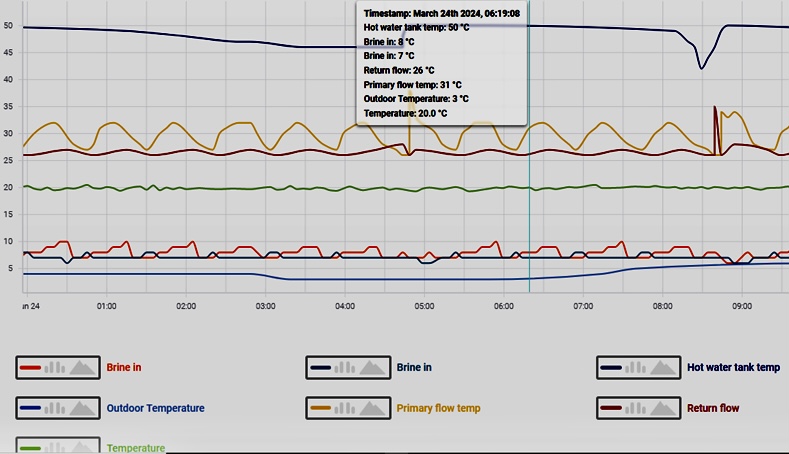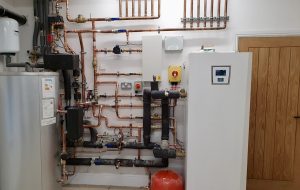Ground Source Heat Pump Systems and Their Design
This article showcases a ground source heat pump installation I spearheaded, with Darren Jones expertly handling the plant room's pipework. At the heart of this project is a 28kW single-phase CTC heat pump, seamlessly integrated with a ground source collector drilled by my son.
The innovative system configuration includes two 14kW brine to water units directly connected to a robust screed underfloor heating setup, avoiding the need for a buffer tank or system separation. The control strategy for the expansive 650 square meter property is straightforward yet effective, relying on the heat pump and adjustable thermostats in four bedrooms, leaving the remainder of the space to be regulated by the heat pump's built-in temperature sensor. This design epitomises an open zone, low-temperature approach, promising excellent efficiency and significantly reduced operational costs.
Additionally, the inclusion of a passive cooling mechanism ensures the home remains comfortable throughout the year, utilising minimal power for maximum comfort.
From the provided graphs, it is evident that with an ambient temperature of 3°C, the house maintained a comfortable 20°C. The brine temperature entering the unit was between 7-8°C, with an average flow temperature of about 30°C. Based on the manufacturer's data, the extrapolated coefficient of performance (COP) ranges between 6 and 6.5. Given that this is at the end of the heating season, and the system has been operational for nearly a year, this COP is the minimum expected.

The system's efficiency is highlighted by its approximately hourly cycling under partial load conditions, demonstrating that a buffer tank or system separation is unnecessary with proper design. Unlike on-off compressors, which are prone to cycling and resultant performance degradation, this system showcases the benefits of precise design and selection.
Our approach to system design is grounded in practical, real-world training offered at Ultimate Training and Technical. This departs from outdated methodologies, moving beyond mere theoretical concepts to embrace modern, evidence-based strategies. With the national average seasonal coefficient of performance (SCOP) around 2.8, and the need for heat pumps to be more cost-effective than fossil fuels necessitating a SCOP of 3.5, our approach emphasises the importance of high SCOPs achievable through the right equipment and meticulous system design and commissioning.
- 26 Forums
- 2,391 Topics
- 54.2 K Posts
- 289 Online
- 6,074 Members
Join Us!
Worth Watching
Latest Posts
-
RE: Weather compensation- why you should use it
Thats quite plausible particularly with radiators. R...
By JamesPa , 6 minutes ago
-
RE: Running from backup generaor in powercut?
@bontwoody Thanks, that a very interesting avenue I had...
By Pipcart , 6 minutes ago
-
RE: Heat pump not reaching flow temperature
is the house warm enough?
By davidnolan22 , 24 minutes ago
-

RE: ASHP Energy Consumption: Aira 12kW heat pump
@wally, welcome to the forums. I’ll probably repeat a ...
By Mars , 57 minutes ago
-
RE: Daikin Atherma ASHP Cycling 6 Times an Hour?
Thanks for your reply. Yes that's a good idea to try a...
By John Marshall , 2 hours ago
-

RE: New Fogstar 15.5kWh upright solution
OK, I'm going to call a halt to this diversion. One o...
By Majordennisbloodnok , 2 hours ago
-

RE: Hot water heating in parallel with space heating
An external heat exchanger would need a pump which woul...
By bontwoody , 2 hours ago
-
RE: Recommended home battery inverters + regulatory matters - help requested
The Sunny boy is old enough that it should be considere...
By JamesPa , 2 hours ago
-
RE: Gen 6 Samsung ASHP losing 20C of DHW in 60 min directly after generation
@ecobaker Thanks for this. I've had it in both slots. ...
By andbeck , 12 hours ago
-

RE: Air source heat pump circuit not operational
Welcome to the forums. If the thermostat shows it’s c...
By Mars , 12 hours ago
-
RE: Ecodan with FTC7 - True Weather Compensation
@danwright90 I've linked two videos below recorded this...
By Sheriff Fatman , 15 hours ago
-

@steelbadger, I’ve pretty much decided now that there’s...
By Majordennisbloodnok , 15 hours ago
-

RE: Advice for a novice on Mitsubishi Ecodan 6kW
That makes plenty of sense. Perhaps more importantly, O...
By Majordennisbloodnok , 16 hours ago
-
RE: Octopus Cosy Heat Pump Owners & Discussion Thread
It does but it almost all applies to boiler systems and...
By JamesPa , 20 hours ago
-
RE: Installer Fitted 9kW Instead of 11kW Heat Pump and Changed MCS Paperwork - What do I do?
So theres a problem for starters. This means that the ...
By JamesPa , 20 hours ago
-
RE: Insulating a pitched roof with kingspan, has anyone done it?
Thank you everyone for all of the information, it looks...
By TRBob , 2 days ago
-
RE: Solar Power Output – Let’s Compare Generation Figures
@transparent Yep, they didn’t even mention it. When ...
By Papahuhu , 2 days ago
-

RE: Setback savings - fact or fiction?
They are lovely, and I feel lucky to live in one, but t...
By cathodeRay , 2 days ago
-
RE: Who's your electricity provider and what's your tariff?
Worth adding that, for this tariff, the Octopus app has...
By Batpred , 2 days ago





